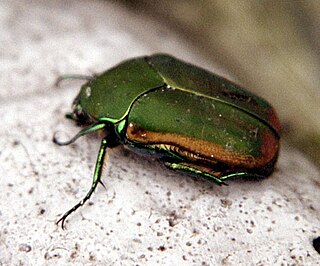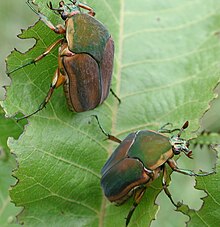
The Lampyridae are a family of insects in the beetle order Coleoptera, with more than 2,000 described species, many of which are light-emitting. They are soft-bodied beetles commonly called fireflies, lightning bugs, or glowworms for their conspicuous production of light, mainly during twilight, to attract mates. Light production in the Lampyridae originated as an honest warning signal that the larvae were distasteful; this was co-opted in evolution as a mating signal in the adults. In a further development, female fireflies of the genus Photuris mimic the flash pattern of Photinus species to trap their males as prey.

Lymantria dispar, known as the gypsy moth, or the spongy moth, is a species of moth in the Erebidae family. Lymantria dispar is subdivided into several subspecies, with subspecies such as L. d. dispar and L. d. japonica being clearly identifiable without ambiguity. Lymantria dispar has been introduced to several continents and is now found in Europe, Africa, Asia, North America and South America. The polyphagous larvae live on a variety of deciduous and coniferous trees and can cause severe damage in years of mass reproduction. Due to these features, Lymantria dispar is listed among the world's 100 worst invasive alien species in the world.

The longhorn beetles (Cerambycidae), also known as long-horned or longicorns, are a large family of beetles, with over 35,000 species described. Most species are characterized by extremely long antennae, which are often as long as or longer than the beetle's body. In various members of the family, however, the antennae are quite short and such species can be difficult to distinguish from related beetle families such as the Chrysomelidae. The scientific name of this beetle family goes back to a figure from Greek mythology: after an argument with nymphs, the shepherd Cerambus was transformed into a large beetle with horns.

The cockchafer, colloquially called Maybug, Maybeetle, or doodlebug, is the name given to any of the European beetles of the genus Melolontha, in the family Scarabaeidae.
June bug or Junebug may refer to:

Polecat is a common name for mammals in the order Carnivora and subfamilies Ictonychinae and Mustelinae. Polecats do not form a single taxonomic rank. The name is applied to several species with broad similarities to European polecats, the only polecat species native to the British Isles, such as having a dark mask-like marking across the face.
Wiregrass is a common name for several plants

Phyllophaga is a very large genus of New World scarab beetles in the subfamily Melolonthinae. Common names for this genus and many other related genera in the subfamily Melolonthinae are May beetles, June bugs, and July beetles. They range in size from 12 to 35 mm and are blackish or reddish-brown in colour, without prominent markings, and often rather hairy ventrally. These beetles are nocturnal, coming to lights in great numbers.

Cotinis nitida, commonly known as the green June beetle, June bug or June beetle, is a beetle of the family Scarabaeidae. It is found in the eastern United States and Canada, where it is most abundant in the South. It is sometimes confused with the related southwestern species figeater beetle Cotinis mutabilis, which is less destructive.

Melolonthinae is a subfamily of the scarab beetles. It is a very diverse group; distributed over most of the world, it contains over 11,000 species in over 750 genera. Some authors include the scarab subfamilies Euchirinae and Pachypodinae as tribes in the Melolonthinae.

Citheronia sepulcralis, the pine-devil moth, is a Nearctic member of the family Saturniidae and of the subfamily Ceratocampinae. The species are blackish brown. The species was first described by Augustus Radcliffe Grote and Coleman Townsend Robinson in 1865.

Amphimallon solstitiale, also known as the summer chafer or European june beetle, is a beetle similar to the cockchafer but much smaller, approximately 20 millimetres (0.79 in) in length. They are declining in numbers now, but where found they are often seen in large numbers. At dusk they actively fly around tree tops looking for a mate and can often be found drowning in pools of water the following morning. They are also attracted to light and come in through open, lit windows and fly around lamps, making quite a racket while bumping into lights. They are found throughout the Palearctic region and, commonly seen from June to August, living in meadows, hedgerows, and gardens, and eating plants and tree foliage.

Cotinis mutabilis, also known as the figeater beetle, is a member of the scarab beetle family. It belongs to the subfamily Cetoniinae, comprising a group of beetles commonly called flower chafers since many of them feed on pollen, nectar, or petals. Its habitat is primarily the southwestern United States and Mexico. Figeater beetles are often mistaken for green June beetles and occasionally Japanese beetles, which occur in the eastern US.

Coccinellidae is a widespread family of small beetles ranging in size from 0.8 to 18 mm. The family is commonly known as ladybugs in North America and ladybirds in Great Britain and other parts of the English-speaking world. Entomologists prefer the names ladybird beetles or lady beetles as these insects are not classified as true bugs.
Palustris is a Latin word meaning "swampy" or "marshy", and may refer to:

The European chafer is a beetle of the family Scarabaeidae. Formerly found only in continental Europe, this invasive species is now found at temperate latitudes in North America. The large, white grubs of A. majale feed on the roots of most cool-latitude grasses, both wild and cultivated. This has made the European chafer an enemy of lawns.

Dexia rustica is a species of fly in the family Tachinidae.

Cotinis is a genus of scarab beetles in the subfamily Cetoniinae found throughout North and South America. At least two species are common pests. The genus was erected by Hermann Burmeister in 1842.

Amphimallon is a genus of beetles of the family Scarabaeidae.

Melolonthini is a tribe of scarab beetles in the family Scarabaeidae. There are over 250 genera in Melolonthini, occurring worldwide; there are over 300 species in North America alone, and more than 3000 worldwide.

















